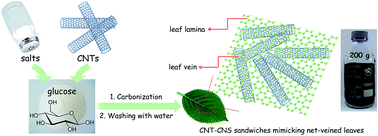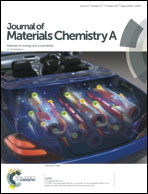Leaf-inspired interwoven carbon nanosheet/nanotube homostructures for supercapacitors with high energy and power densities†
Abstract
The rational design and scalable synthesis of hierarchical porous carbon as an electrode material for high-energy-density supercapacitors has drawn wide interest. Herein, we report an environmentally friendly one-pot strategy for the synthesis of interwoven carbon nanotube (CNT)/carbon nanosheet (CNS) sandwiches in a molten salt. Green and cheap biomass glucose was chosen as the precursor for producing CNSs at a pyrolysis temperature of 700 °C in a conventional inorganic salt mixture (LiCl and KCl eutectic), while commercially available CNTs were introduced as veins sandwiched with CNS laminae. Relying on the compositional and structural superiorities benefitting from mimicking net-veined leaves, the unique CNT/CNS sandwiches manifest excellent electrochemical capacitive performance in terms of high specific energy (23.6 W h kg−1), excellent rate capacitance retention (∼75% at 10 A g−1) and exceptional cycling stability (capacitance retention of ∼100% after 5000 cycles).



 Please wait while we load your content...
Please wait while we load your content...